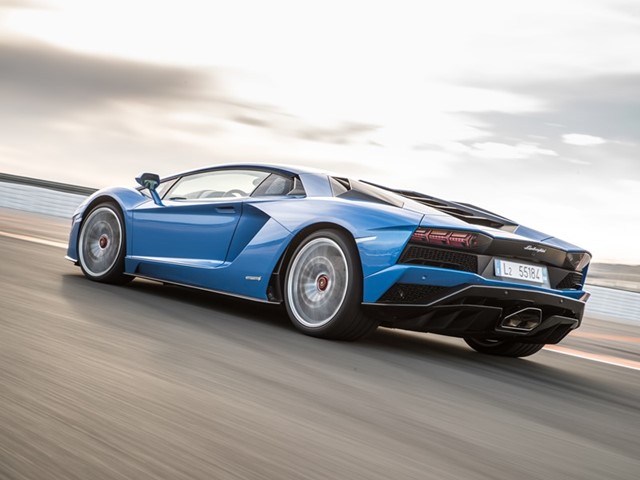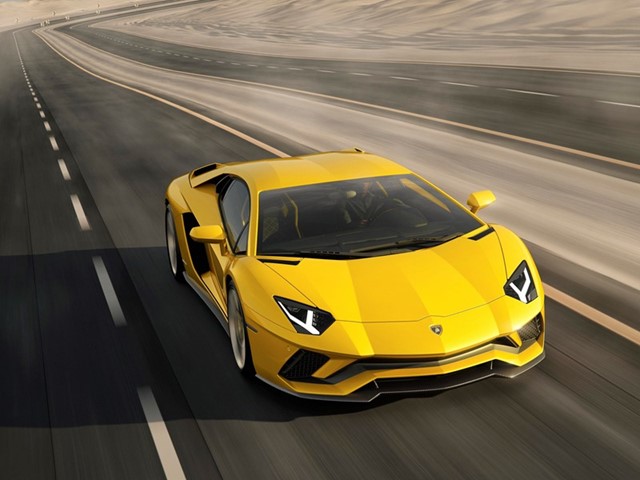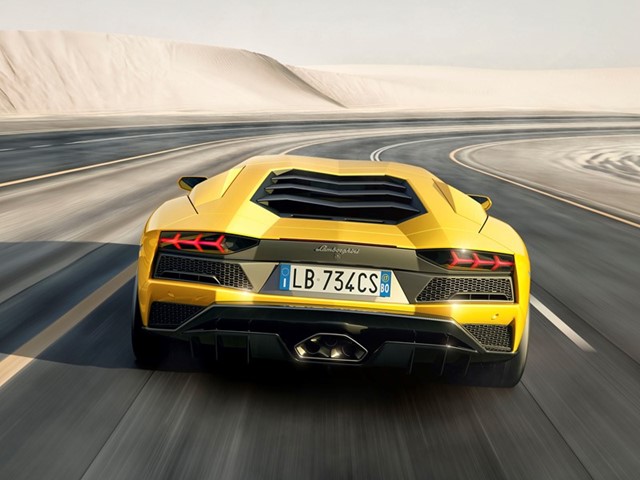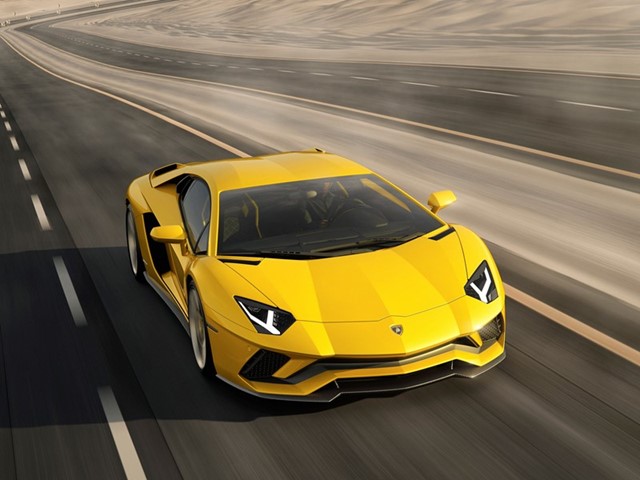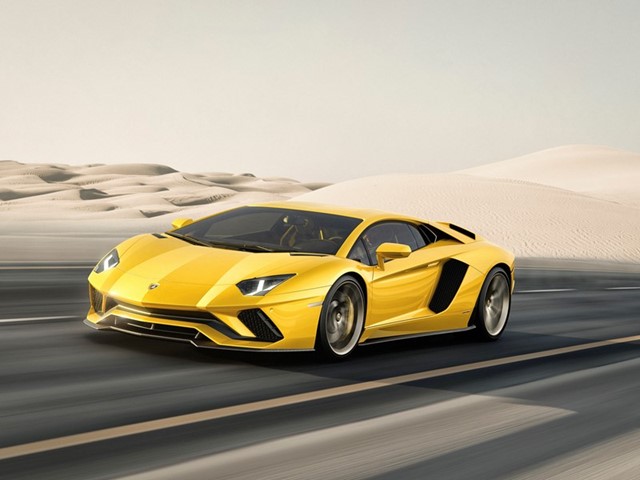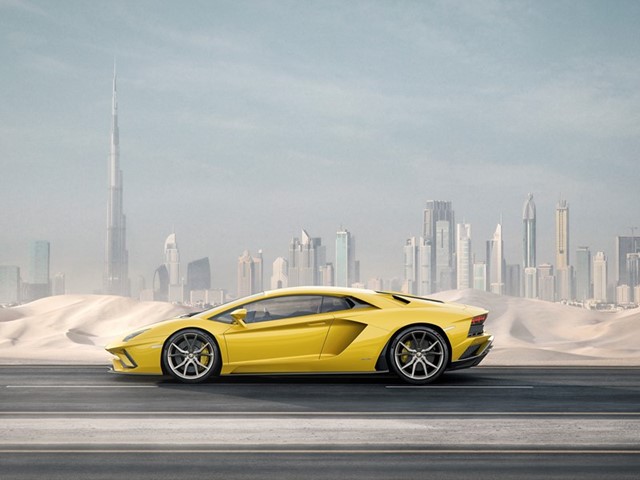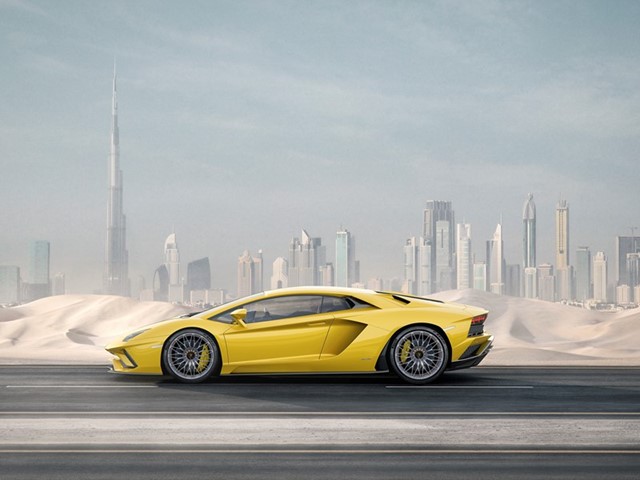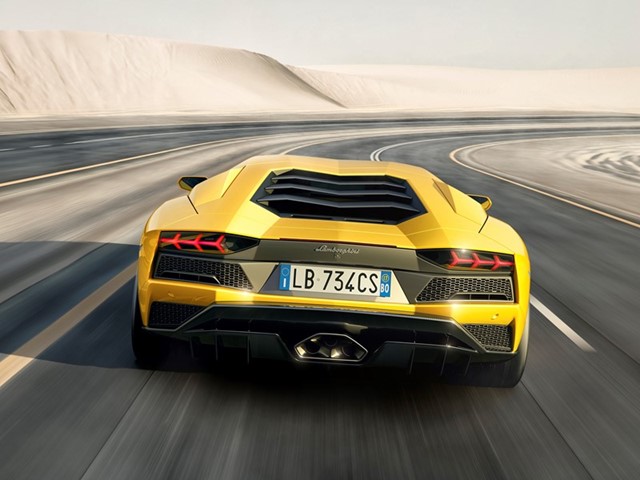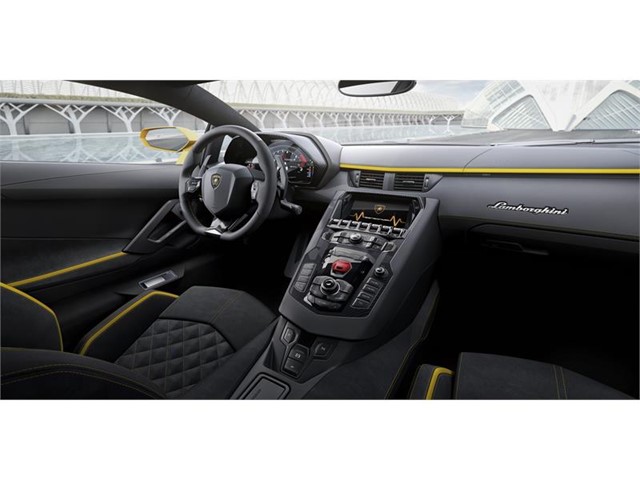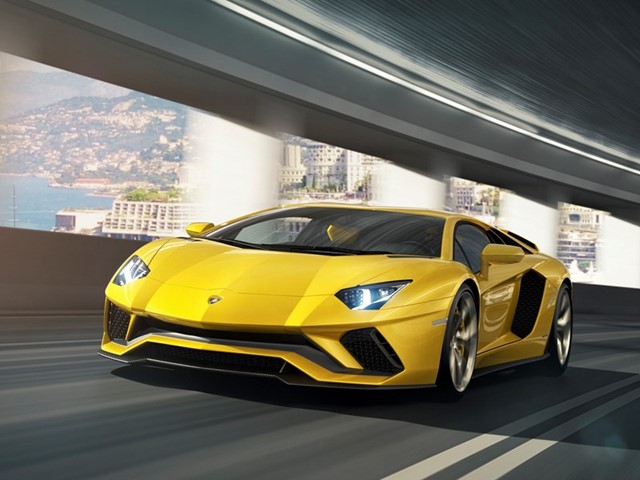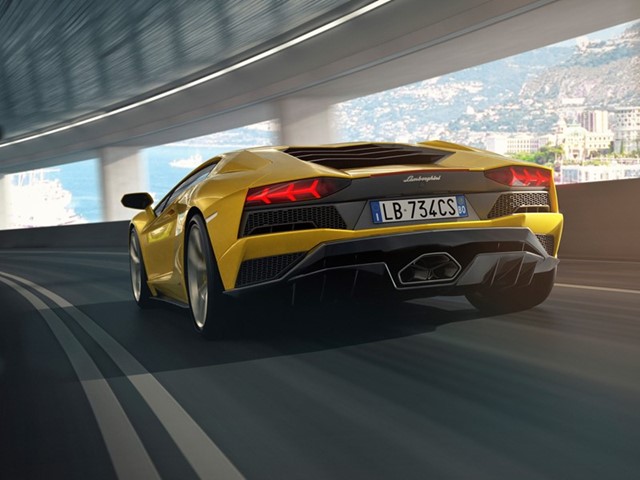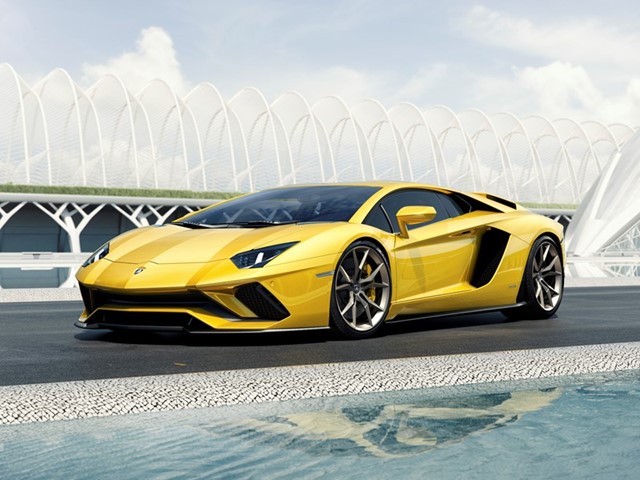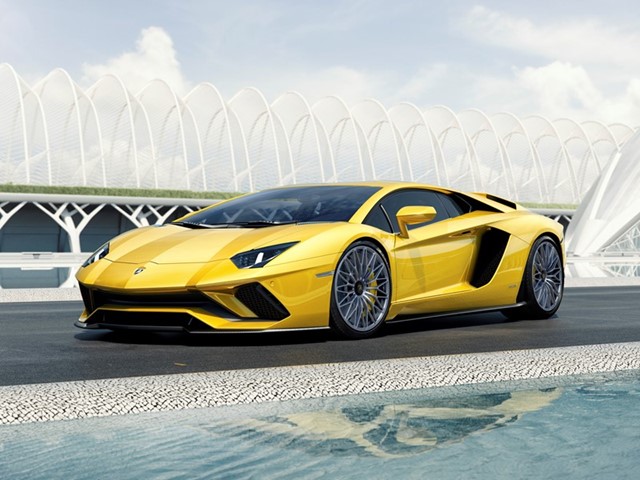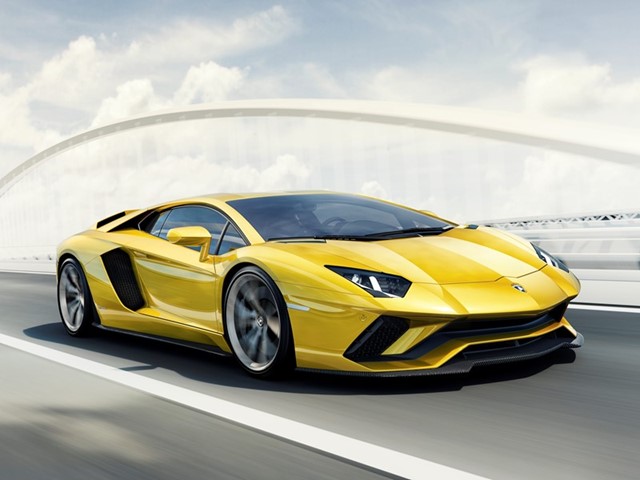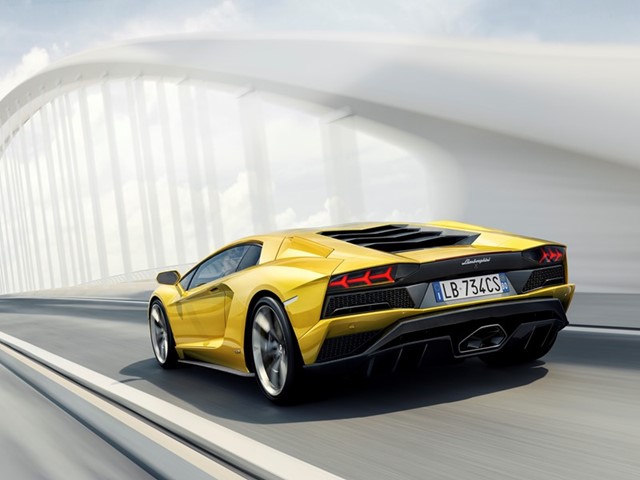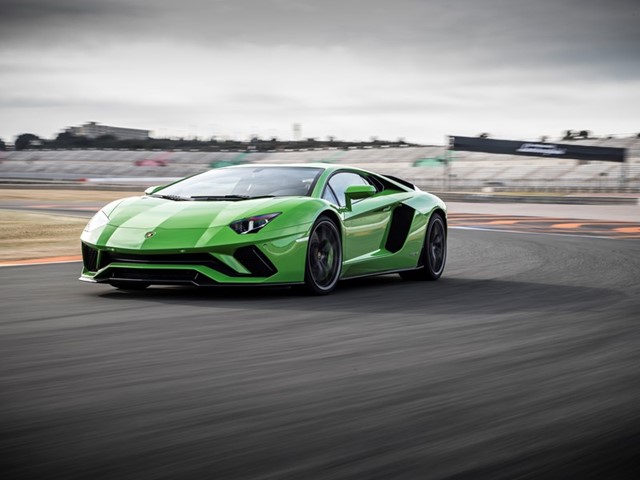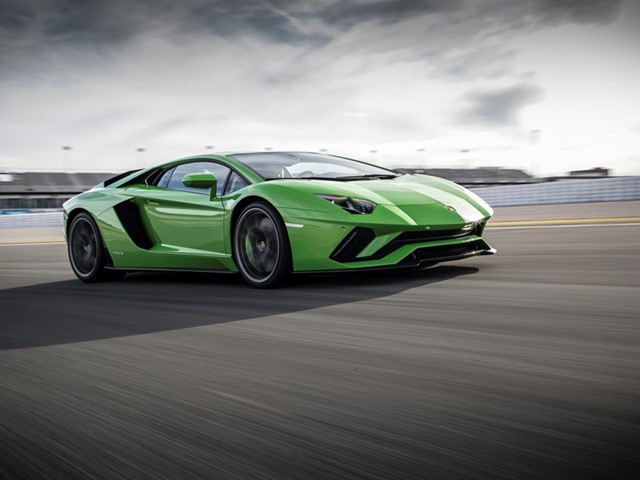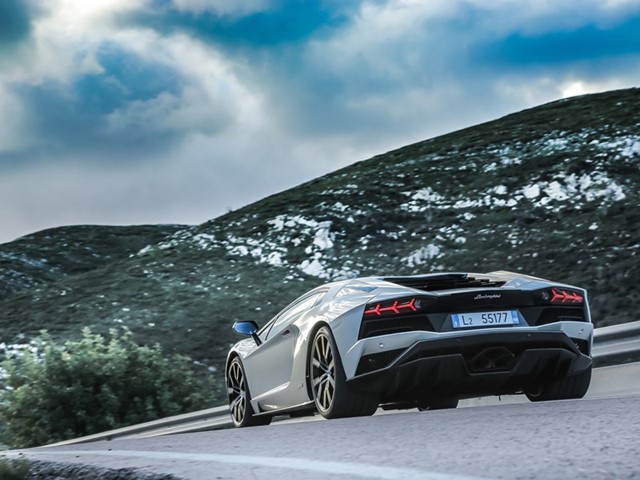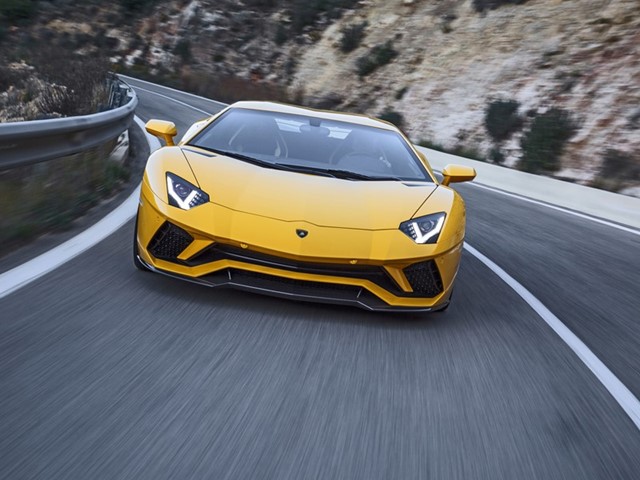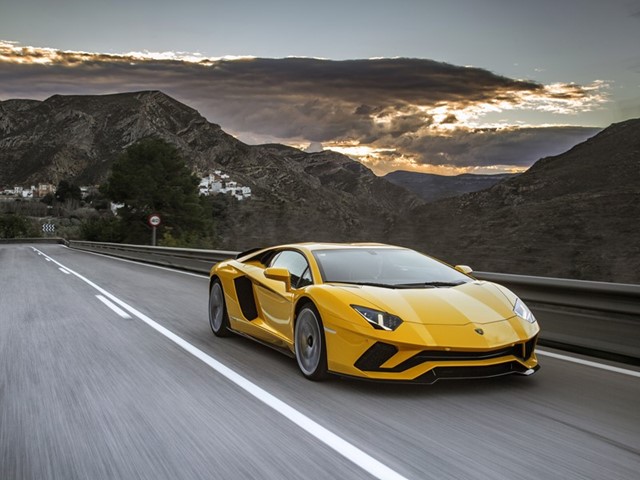Lamborghini Aventador S
2017 – Present
Base price: US$417,650 / Engine: 6.5L Naturally Aspirated V12 / Power: 730 hp @ 8,400 rpm / Torque: 507 lb-ft @ 5,500 rpm / 0-60 mph: 2.9 sec / 0-124 mph: 8.8 sec / Top Speed: 217 mph
The entry level Aventador is now known as the Aventador S. It still has a mid-engined naturally aspirated 6.5 liter V12 engine with 730 horsepower and 509 lb/ft of torque. It still has a unique seven-speed automated-manual transmission and all-wheel drive. The formula is unchanged – crazy looks, lots of noise, insane power and drama. The big updates to the platform for S were the new AWD system, new control unit for active systems. The result is a livelier and more fun car to drive than the original Aventador.
For all its likeably flamboyant design and visceral performance, the Lamborghini Aventador never quite delivered on its promise. The chassis in particular tended to feel a little leaden. So now Lamborghini is upping the ante with the Aventador S.
The Aventador’s frankly stunning performance figures, from the 2.9sec 0-62mph time to the 217mph top end, remain unchanged. But to judge the improvements Lamborghini has implemented based on data alone is to entirely miss the point. Because a) the Aventador always had plenty enough performance, and b) the S version is a dramatic improvement over went before.
Design boss Mitja Borkert hasn’t messed too much with the looks, but you might notice the new fangs on the front bumper, the cleaner side intakes and the new BBS-like cross-spoke wheels (which look a little flat to our eyes). Don’t worry, it still turns heads.
Inside, it’s business as usual: you glimpse the carbonfibre monocoque as you raise the dramatic doors, the windscreen races over your head, the centre console seems so rakish it’s almost flat, and you’re still a bit too aware of Audi switchgear. However, there is a new TFT display in the instrument binnacle. This changes according to driver mode, but always features an arcade-game-like font – it fittingly emphasises the Aventador’s sci-fi otherworldliness, like you’re driving a spaceship.
But no, really, this isn’t about the facelift, it’s about the driving dynamics.
The key difference is the new rear-wheel steering system, which works much like the systems fitted to the Porsche 911 GT3 and Ferrari F12 TdF. Below 81mph, the rear wheels turn in the opposite direction to the fronts by up to three degrees, just 5ms after you’ve made a steering input. It effectively makes the wheelbase feel shorter, much like a forklift truck. Above 81mph, all four wheels turn in the same direction, with the rears turning by up to 1.5 degrees. This effectively makes the wheelbase longer.
There’s new rear suspension hardware to account for the turning rear wheels, the springs are 20% stiffer and the magnetorheological dampers have been recalibrated. The Pirelli P Zeros are a new design – even the tread appears different – with 355/25 ZR21s on the rear.
The all-wheel drive system is also tuned to be more rear-biased, and sends less torque forwards when you decelerate. The idea is you’ll get a more agile, rear-drive feel when you turn in to a corner.
As before, the system also changes its torque split based on the drive mode, with up to 90% of torque flowing rearwards in Sport mode, less in Strada (Street) and Corsa (Race) modes – the latter to prioritise clawing grip for faster lap times in the most hardcore setting. A new Ego drive mode debuts too, allowing you to mix and match your choices for the powertrain, chassis and steering settings. Lamborghini Active Vehicle Dynamics – a new brain – takes care of marrying everything up.
Handily, Lamborghini let us drive old and new Aventadors back-to-back, on a short slalom they’d set up at Circuit Ricardo Tormo. The difference isn’t subtle. Where the old car feels very nose-led and slightly stubborn, its steering lethargic where you need flighty flicks left-to-right, the S dances through the slalom with a balance that feels much more in line with your hips, and steering that feels light years faster. You’re also more aware of that heavy V12 shifting about behind you, helping point the nose just to the left or right of the cones we’re dodging.
Not only does the S feel a giant leap in terms of agility, it also feels much lighter too, because of the increased hunger for direction changes. And yet it weighs exactly the same.
The V12’s been downsized and turbocharged… only joking. No, the Aventador sticks with the glorious 6.5-litre V12 engine, naturally aspirated and a fantastic riposte to everyone who says they had no choice but to give us smaller blown units. The noise is heaven, all raucous yelps at high revs and theatrical thunderclaps on down shifts, the instant response flings you forward at seemingly any revs, and the power builds ferociously all the way to 730bhp at 8400rpm, and now screams 200rpm higher at 8500rpm. Technologically off-the-pace, maybe, but its soul, emotion and passion more than compensates.
The differences in feel between old and new engine specs is less obvious than the chassis, but there’s 39bhp extra, if no additional torque at 509lb ft. Despite its 730bhp being just 10bhp shy of the hardcore Aventador SV, the philosophy is different: the SV’s 100kg weight loss gives it permission to focus more on power, where Lamborghini’s engineers have also targeted driveable torque for the S. So the new airbox can be virtually split into smaller or larger sections by the use of four separate drive-by-wire throttles – all throttles deployed for full power, fewer throttles to increase low-speed torque. Trust me, you won’t want a turbo.
A lighter exhaust is said to offset the weight gain of the rear-steering system, meaning the chunky 1575kg dry weight remains unchanged.
The seven-speed automated manual gearbox of course remains. There’s still a little hole in the delivery when you shift at lower speeds – a Ferrari dual-clutch transmission feels far more sophisticated in this respect – but Lamborghini says they’ve targeted low-speed refinement, and it surely won’t be a deal breaker if you’re already prepared to use a car as radical as this in town. And when you’re flat-out on the racetrack, pulling those paddles as the revs zing towards 8500rpm? You don’t need faster changes, and there’s a lovely physicality to the shift that stops short of unnecessarily theatrical brutality.
Amazing. We were privileged to follow Lamborghini test driver Mario Fasanetto, who was piloting an SV and not hanging about. The Aventador S is a fantastically quick supercar with some old-school rawness to it, but it’s still highly accomplished.
On racetrack corners much faster than the slalom we also tested on, you can feel the effects of the rear-wheel steering, the extra torque that’s been kept at the rear wheels when you decelerate and the weight of the V12 behind you; the S really wants to turn in – it’s almost nervously keen to do so – and it’s here you’re most likely to overcook things and get a slide on. You might also need to add steering correction even when you’re off-throttle in a slower corner, so keen is this Lambo to point its snout down the next straight. But otherwise, this is a very sure-footed all-wheel drive chassis, with immense traction combined with a lovely rear-biased adjustability.
It allows you to work that 730bhp very hard and have fun, with very little understeer – make it scrub and, really, you’re just doing it wrong.
If the Aventador was a disappointment, the S is a revelation. Don’t let the similarity of design or performance fool you, this is a very different feeling supercar, and the key to its new-found engagement is its revised chassis, particularly the new rear-wheel steering system. An SV still manages to be the driver’s choice, but the S feels far more closely aligned to that hardcore range-topper than it does its predecessor.
The Aventador has always been unique in its segment, but the S takes it to a whole new level. Would we buy one? Absolutely.
2017 Lamborghini Aventador S Press Release
The Lamborghini Aventador S: Elevating the benchmark for super sports cars
• The next generation of the V12 Lamborghini flagship • New iconic design features focused on aerodynamic performance • New four-wheel steering system • Significantly enhanced suspension and electronics, and customisable driving modes • More powerful naturally aspirated V12 engine outputting 740 hp • 0-100km/h in 2.9 seconds, top speed of 350 km/h
S a n t ’ A g a t a B o l o g n e s e , 1 9 D e c e m b e r 2 0 1 6 – The new Lamborghini Aventador S is characterized by new aerodynamic design, redeveloped suspension, increased power and new driving dynamics. The ‘S’ is the suffix of previous enhanced Lamborghini models and defines a new benchmark for the V12 Lamborghini.
“This is the next generation Aventador as well as the expression of new technological and performance milestones in super sports car development,” says Automobili Lamborghini Chairman and Chief Executive Officer Stefano Domenicali. “The Aventador S is visionary design, cutting-edge technology and driving dynamics in pure harmony, and elevates the concept of super sports cars to a new level.”
Design and Aerodynamics
The design of the new Aventador S clearly indicates the new Aventador generation. The Aventador S features a number of exterior developments, particularly in front and rear, while its profile remains clearly an Aventador. Every modified component is redesigned for a purpose, achieving maximum aerodynamic efficiency while accenting the Aventador’s complex, muscular dynamism. Furthermore, Lamborghini Centro Stile has intelligently integrated certain elements of past icons, such as the lines of rear wheel arches reminiscent of the original Countach.
A more aggressive nose and longer front splitter redirect airflow for better aerodynamic efficiency, improved engine cooling and increased cooling to the radiators. Two air ducts in the side of the front bumper reduce aerodynamic interference from the front tires and optimize wake flow to the rear radiator.
The rear of the Aventador S is dominated by a black diffuser, available on request in carbon fiber, characterized by a number of vertical fins that amplify the airflow effects, reduce drag through pressure recovery and generate downforce. Three single exhaust outlets exit through the rear bumper.
The active rear wing is movable in three positions depending on speed and drive select mode, and optimizes the car’s improved overall balance, working with vortex generators created in the front and rear of the chassis’ underside that maximize air flow as well as assist in brake cooling.
The Aventador S design results in significantly enhanced aerodynamic performance. Front downforce has been improved by more than 130% over the previous Aventador coupé. When the wing is in its optimum position the overall efficiency at high downforce is improved by over 50%, and in low drag by more than 400% compared to the previous model.
Four masterpieces evolve driving emotion: Four-wheel drive, new active suspension, new four-wheel steering system and the new EGO driving mode
The Aventador S chassis retains the Aventador’s unique and extremely rigid lightweight carbon fiber monocoque with attached aluminum frames resulting in a dry weight of just 1,575 kg.
The Aventador S is redeveloped around a ‘total control concept’ to provide a superior drive, ride and performance; every aspect of the car’s suspension and electronic control systems has been advanced, with the goal of particularly enhanced control and driving emotion.
Enhanced lateral control comes from new four-wheel steering, adopted for the first time on a series production Lamborghini. The system provides improved agility at low and medium speeds and more stability at high speed. On the front axle it is combined with Lamborghini Dynamic Steering (LDS), tuned for a more natural and responsive feel with a sharper turn-in. It is specially adapted to integrate with the active Lamborghini Rear-wheel Steering (LRS) on the rear axle: two separate actuators react in five milliseconds to driver’s steering movements, allowing a real-time angle and cornering stiffness adjustment.
At low speeds, rear wheels wheels face in opposite direction to the steering angle, thereby virtually reducing the wheelbase. With less steering wheel angle required, the Aventador S is more agile with a reduced turning radius, ensuring higher performance in curves and making it easy to maneuver in town and at low speeds.
Conversely at higher speeds both front and rear wheels share the same steering angle, thus virtually extending the wheelbase, providing increased stability and optimizing the responsiveness of the car.
Vertical control comes from Lamborghini’s updated pushrod and Lamborghini Magneto-rheological Suspension (LMS), with revised kinematics adapted to the new four-wheel steering. New suspension geometry, optimized for Lamborghini Rear-wheel Steering, includes upper and lower arm and wheel carrier to reduce caster and load on the system. A new real-time variable damping system optimizes wheel and body control, and balance and ground stiffness is maximized. New rear springs also enhance the car’s balance.
Longitudinal control is achieved via an improved ESC strategy with faster and more precise control of traction control and vehicle dynamics, depending on the driving mode selected. Extensively tested on surfaces such as snow and ice, the Aventador S has improved adhesion detection to maximize grip in all conditions and enhance its handling capabilities. The Aventador S permanent four-wheel drive has been calibrated for the stabilizing effect of the new Lamborghini Rear-wheel Steering, allowing more torque to the rear axle: when powering off the throttle, less torque is shifted to the front axle to allow oversteer behavior and a sporty, but safe drive.
Lamborghini engineers have integrated the smart Lamborghini Dinamica Veicolo Attiva (LDVA) control unit to manage these systems in the car. LDVA is the new brain of the car, which receives real time and precise information on body motion via input from all sensors of the car. It instantly defines the best set-up of all active systems in order to guarantee the best vehicle dynamics in each and every condition.
EGO concept – customizable driving modes
The Aventador S allows the driver to select between four different driving modes: STRADA, SPORT, CORSA and the new EGO mode, which influence the behavior of traction (engine, gearbox, 4WD), steering (LRS, LDS, Servotronic) and suspension (LMS).
STRADA stands for maximum comfort and daily use. SPORT provides a sporty, rear-wheel drive feel and CORSA is suitable for maximum track performance.
EGO is the new driving mode option. This provides several additional and individual set-up profiles, customizable by the driver, selecting his preferred criteria for traction, steering and suspension within the STRADA, SPORT and CORSA settings.
All driving modes have been recalibrated in the Aventador S, improving ESC integration with all-wheel drive and the interface between engine torque management system and traction control reaction. The continuous torque split to front and rear axles in each driving mode is recalibrated for the Lamborghini Rear-wheel Steering and the differentiation between the driving modes is enhanced.
In STRADA, the progressive damping is smoothed for better comfort and stability on rough roads. Torque is split 40/60 to the front and rear as standard: safe and stable with maximum adhesion, the car is easily driven and controlled.
In SPORT mode, the stabilizing effect of the Lamborghini Rear-wheel Steering allows up to 90% torque to the rear wheels for maximum sportiness and driving fun on curving roads. Driving precision and driver feedback is improved, while maintaining safety and without compromising on comfort. When powering off the accelerator, less torque is shifted to the front axle to enhance the car’s agility, with oversteer and drifting easy using light throttle and steering wheel control.
In CORSA, drivers experience less intrusive dynamic and traction control intervention while maintaining driving precision and traction. High levels of damping force maximize driver feeling and feedback from driver inputs including steering, braking and throttle. Counter-phase steering is enhanced in high-performance situations and torque is balanced to both axles, with a maximum 20/80 split to front and rear for more neutral behavior and to maximize track-oriented performance.
The engine and exhaust
The Lamborghini Aventador’s naturally aspirated twelve cylinder, 6.5 liter engine outputs an additional 40 hp over its predecessor, to a maximum 740 hp, with a 690 Nm of torque at 5,500 rpm. To achieve the power increase, both VVT (Variable Valve Timing) and VIS (Variable Intake System) have been optimized in order to obtain an enriched torque curve. Additionally, the maximum engine revs have been increased from 8,350 to 8,500 rpm. A dry weight of just 1,575 kg provides a weight-to-power ratio of just 2.13 kg/hp. Acceleration from 0-100 km/h is reached in 2.9 seconds, with a top speed of 350 km/h. Transmission is provided by Lamborghini’s lightweight Independent Shifting Rod (ISR) 7-speed shifting system, providing robotized gear shifts in up to 50 milliseconds.
The Aventador S adopts a new exhaust system developed as the result of a significant R&D project. More than 20% lighter than its predecessor and the product of testing multiple configurations, the results are an enhanced
Lamborghini sound and resonance from the already inimitable V12 aspirated engine, with the three single pipe outlets at the rear of the Aventador S a visual reminder of the new exhaust system.
As in its predecessor, the Aventador S is equipped with a stop-and-start system and cylinder deactivation for optimized engine efficiency. When full engine capacity is not required, six of the twelve cylinders are temporarily deactivated by switching off one cylinder bank. When the driver accelerates, the system switches back instantaneously to twelve-cylinder mode, with the changeover virtually impossible to detect by the driver.
Tires and braking system
The Aventador S sits on a new, specially developed set of Pirelli P Zero tires. Designed to optimize steering, traction, lane changes and braking efficiency, the tires are specifically designed to respond to the dynamic behavior induced by the Lamborghini Rear-wheel Steering, ensuring handling consistency and driver feedback. With improved force generation from both front and rear tires, the Pirelli P Zero tires provide a higher lateral acceleration and reduce understeer characteristics.
Carbon ceramic brakes are standard equipment for the Aventador S. The ventilated and perforated carbon ceramic discs (Ø 400 x 38 mm – Ø 380 x 38 mm) enhance braking performance from 100 km/h to standstill in 31 m. Aventador S – a driver’s environment
The cockpit of the Aventador S brings new functionality and refinement. A new TFT digital dashboard can be customized according to the driver’s preferences, with different kombi screens for STRADA, SPORT and CORSA in conjunction with the EGO mode. Selected from the driving modes options on the control panel, the EGO button reveals further options on pop-up digital screens, allowing the driver to choose his preferred settings.
AppleCarPlay comes as a standard specification, allowing the cockpit’s occupants to manage voice activated communications and entertainment from personal Apple devices.
The Lamborghini telemetry system is an optional specification: recording lap times and track performance as well as trip data, the telemetry system is especially appealing to the owner who wants to take his car on track.
The interior specification of the Aventador S is virtually limitless through Lamborghini’s Ad Personam customization program.
Price of the Lamborghini Aventador S and market delivery
The first customers will take delivery of the new Lamborghini Aventador S in Spring 2017 at suggested retail prices as follows:
Europe: EUR 281.555,00 (suggested retail price taxes excluded)
UK: GBP 225.955,00 (suggested retail price taxes excluded)
USA: USD 421.350,00 (suggested retail price – GGT included)
China: RMB 6.739.673,00 (suggested retail price taxes included)
Japan: YEN 41.578.179,00 (suggested retail price taxes included)
2017 Lamborghini Aventador S Photos
2017 Lamborghini Aventador S Specs
Mileage |
|
| EPA Fuel Economy Est – Hwy : MPG | 18 (Est) |
| Cruising Range – City : mi | 261.80 |
| EPA Fuel Economy Est – City : MPG | 11 (Est) |
| Fuel Economy Est-Combined : MPG | 13 (Est) |
| Cruising Range – Hwy : mi | 428.40 |
| EPA MPG Equivalent – City : | N/A |
| EPA MPG Equivalent – Hwy : | N/A |
| EPA MPG Equivalent – Combined : | N/A |
| Battery Range : mi | N/A |
Fuel Tank |
|
| Fuel Tank Capacity, Approx : gal | 23.8 |
| Aux Fuel Tank Capacity, Approx : gal | N/A |
Cargo Area Dimensions |
|
| Trunk Volume : ft³ | N/A |
Brakes |
|
| Brake Type : | N/A |
| Brake ABS System : | 4-Wheel |
| Brake ABS System (Second Line) : | N/A |
| Disc – Front (Yes or ) : | Yes |
| Disc – Rear (Yes or ) : | Yes |
| Front Brake Rotor Diam x Thickness : in | 15.7 |
| Rear Brake Rotor Diam x Thickness : in | 15 |
| Drum – Rear (Yes or ) : | |
| Rear Drum Diam x Width : in | |
Emissions |
|
| Tons/yr of CO2 Emissions @ 15K mi/year : | 13.6 (Est) |
| EPA Greenhouse Gas Score : | N/A |
Transmission |
|
| Drivetrain : | All Wheel Drive |
| Trans Order Code : | |
| Trans Type : | 7 |
| Trans Description Cont. : | Auto-Shift Manual w/OD |
| Trans Description Cont. Again : | |
| First Gear Ratio (:1) : | 3.91 |
| Second Gear Ratio (:1) : | 2.44 |
| Third Gear Ratio (:1) : | 1.81 |
| Fourth Gear Ratio (:1) : | 1.46 |
| Fifth Gear Ratio (:1) : | 1.19 |
| Sixth Gear Ratio (:1) : | 0.97 |
| Reverse Ratio (:1) : | 2.93 |
| Clutch Size : in | N/A |
| Final Drive Axle Ratio (:1) : | 2.86 |
| Seventh Gear Ratio (:1) : | 0.89 |
Vehicle |
|
| EPA Classification : | Two-Seaters |
Interior Dimensions |
|
| Passenger Capacity : | 2 |
| Passenger Volume : ft³ | 50 |
| Front Head Room : in | N/A |
| Front Leg Room : in | N/A |
| Front Shoulder Room : in | N/A |
| Front Hip Room : in | N/A |
| Second Head Room : in | N/A |
| Second Leg Room : in | N/A |
| Second Shoulder Room : in | N/A |
| Second Hip Room : in | N/A |
Weight Information |
|
| Base Curb Weight : lbs | 4085 |
Trailering |
|
| Dead Weight Hitch – Max Trailer Wt. : lbs | N/A |
| Dead Weight Hitch – Max Tongue Wt. : lbs | N/A |
| Wt Distributing Hitch – Max Trailer Wt. : lbs | N/A |
| Wt Distributing Hitch – Max Tongue Wt. : lbs | N/A |
Engine |
|
| Engine Order Code : | |
| Engine Type : | Premium Unleaded V-12 |
| Displacement : | 6.5 L/397 |
| Fuel System : | Sequential MPI |
| SAE Net Horsepower @ RPM : | 691 @ 8250 |
| SAE Net Torque @ RPM : | 507 @ 5500 |
Electrical |
|
| Cold Cranking Amps @ 0° F (Primary) : | 380 |
| Maximum Alternator Capacity (amps) : | 190 |
Cooling System |
|
| Total Cooling System Capacity : qts | N/A |
Suspension |
|
| Suspension Type – Front : | Double Wishbone Pushrod |
| Suspension Type – Rear : | Double Wishbone Pushrod |
| Suspension Type – Front (Cont.) : | Double Wishbone Pushrod |
| Suspension Type – Rear (Cont.) : | Double Wishbone Pushrod |
| Shock Absorber Diameter – Front : mm | N/A |
| Shock Absorber Diameter – Rear : mm | N/A |
| Stabilizer Bar Diameter – Front : in | N/A |
| Stabilizer Bar Diameter – Rear : in | N/A |
Tires |
|
| Front Tire Order Code : | |
| Rear Tire Order Code : | |
| Spare Tire Order Code : | |
| Front Tire Size : | P255/35YR19 |
| Rear Tire Size : | P335/30YR20 |
| Spare Tire Size : | |
Wheels |
|
| Front Wheel Size : in | 19 X 9 |
| Rear Wheel Size : in | 20 X 12 |
| Spare Wheel Size : in | |
| Front Wheel Material : | Aluminum |
| Rear Wheel Material : | Aluminum |
| Spare Wheel Material : | |
Steering |
|
| Steering Type : | Rack-Pinion |
| Steering Ratio (:1), Overall : | N/A |
| Lock to Lock Turns (Steering) : | N/A |
| Turning Diameter – Curb to Curb : ft | 41 |
| Turning Diameter – Wall to Wall : ft | N/A |
Exterior Dimensions |
|
| Wheelbase : in | 106.3 |
| Length, Overall : in | 188.2 |
| Width, Max w/o mirrors : in | 79.9 |
| Height, Overall : in | 44.7 |
| Track Width, Front : in | 67.7 |
| Track Width, Rear : in | 66.9 |
| Min Ground Clearance : in | 4.1 |
| Liftover Height : in | N/A |
2017 Lamborghini Aventador S Videos


